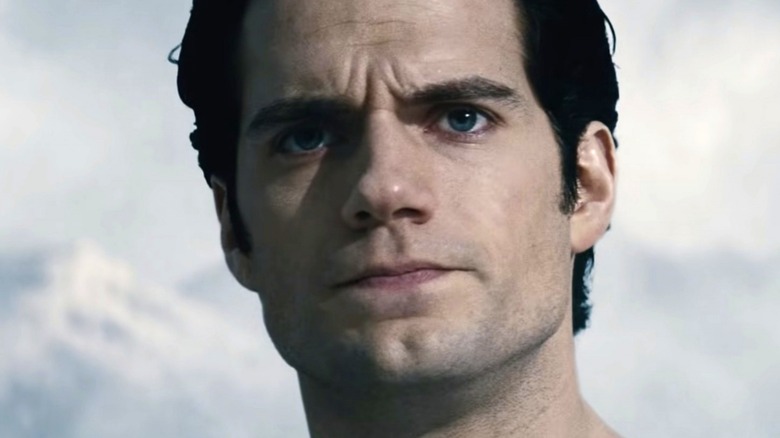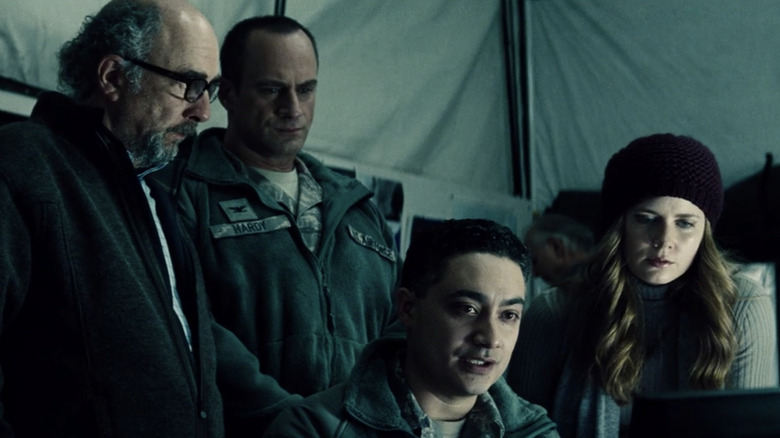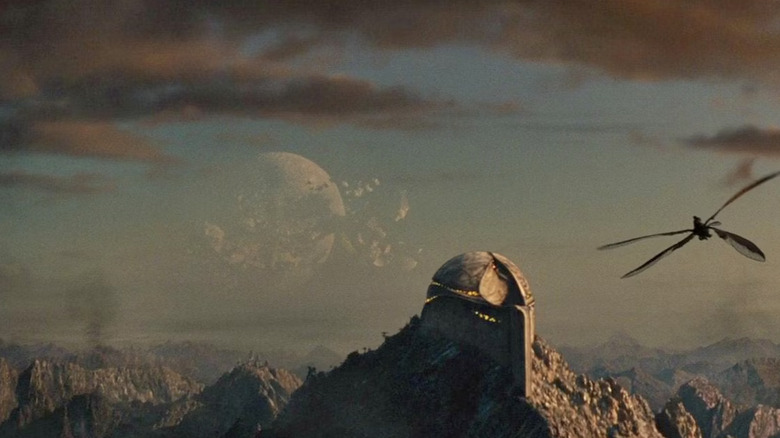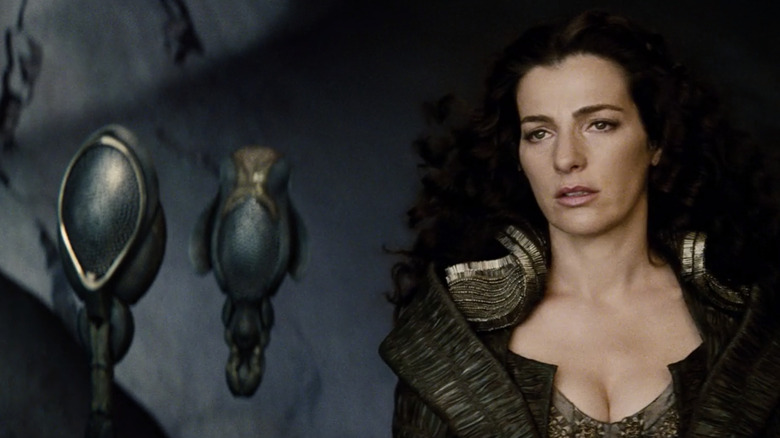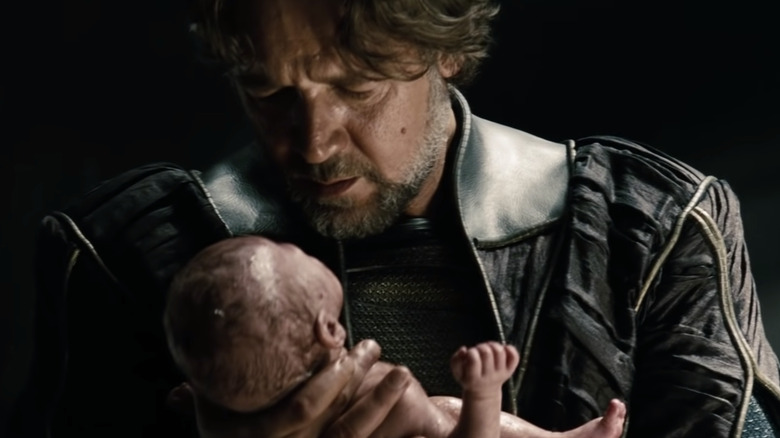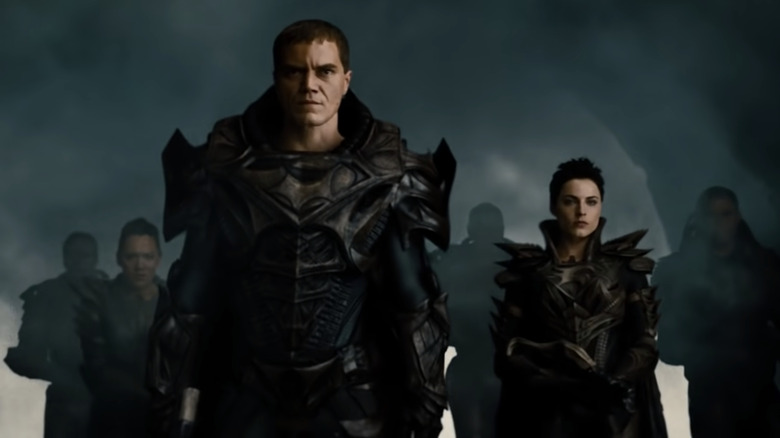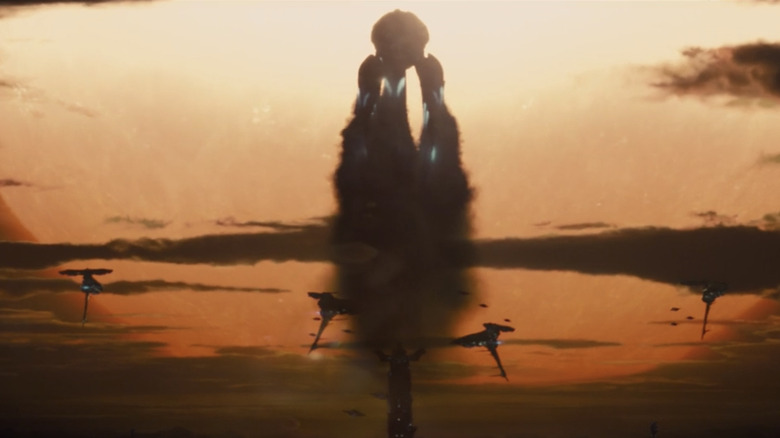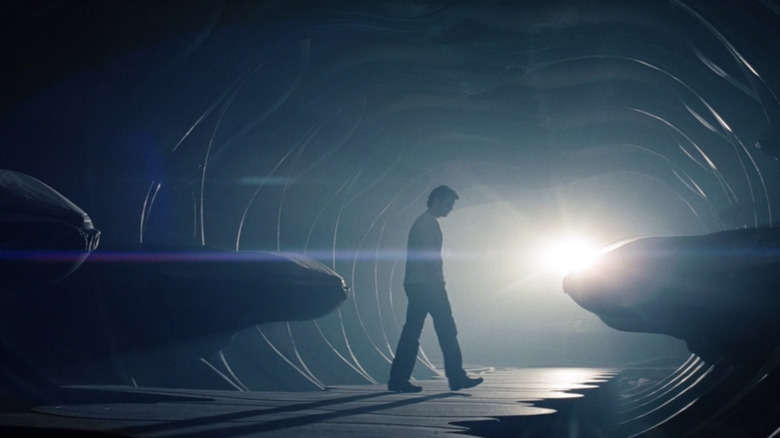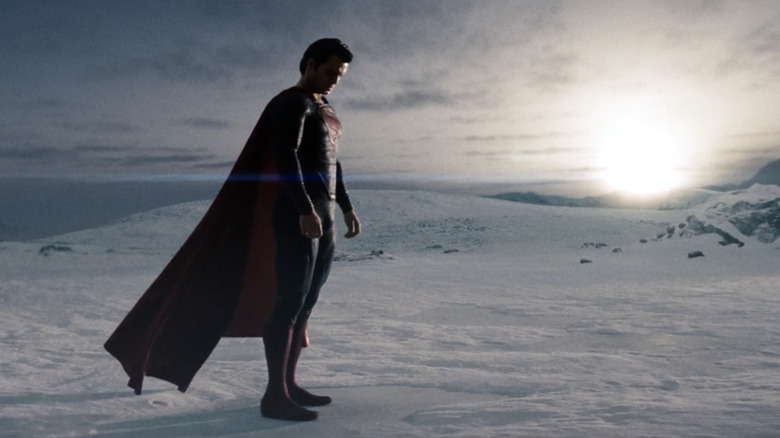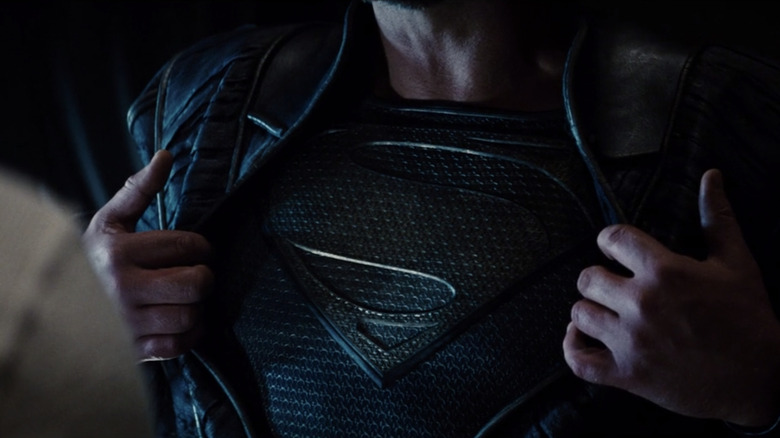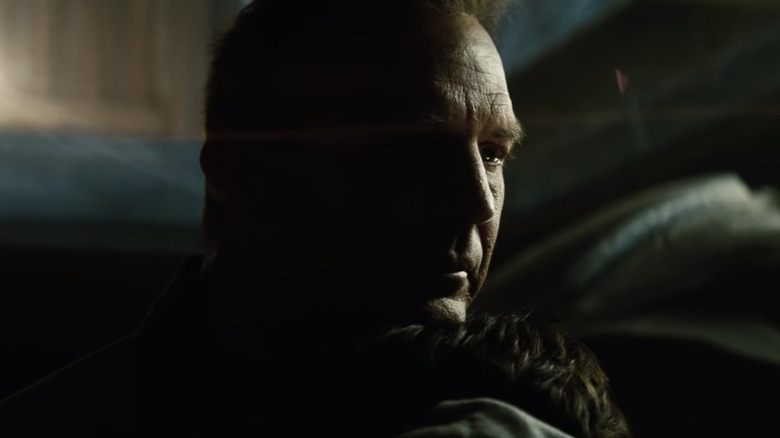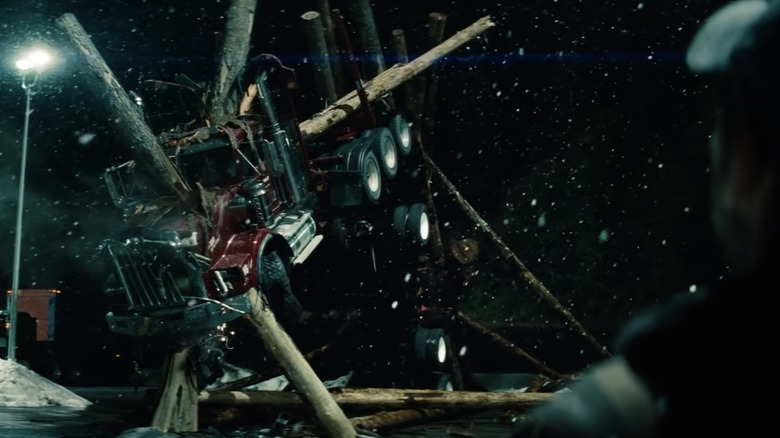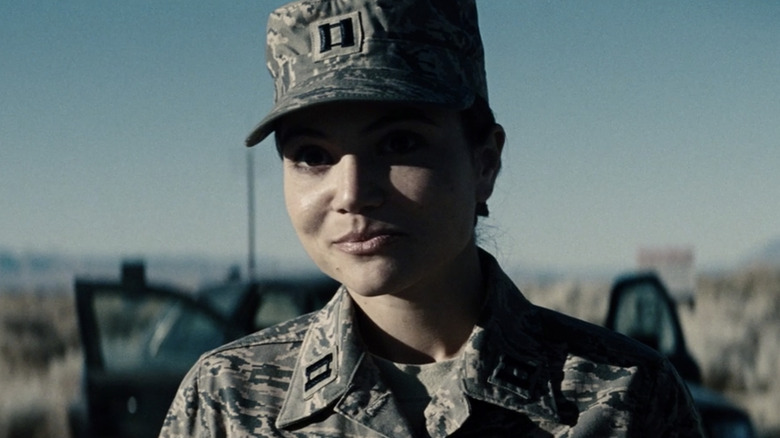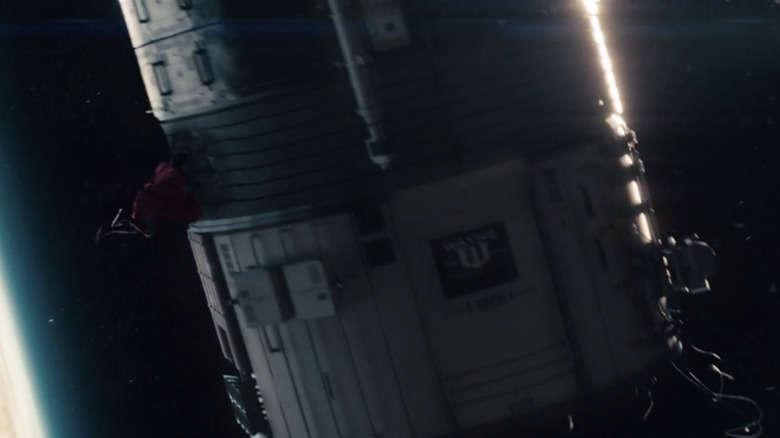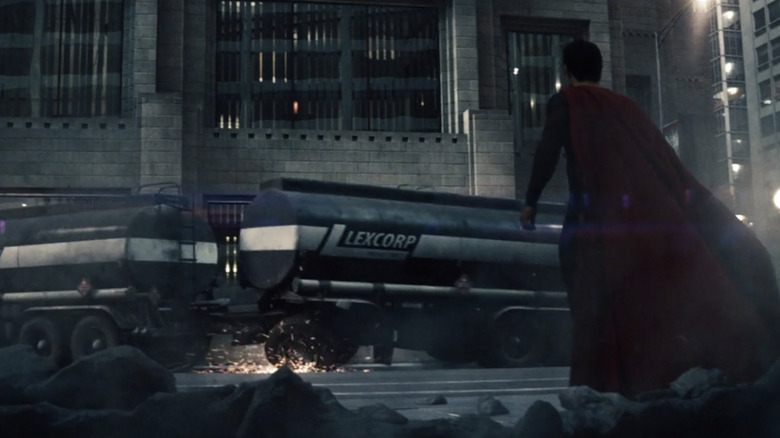Easter Eggs In Man Of Steel You Probably Never Noticed
The year 2013 was a significant landmark for Superman fans everywhere as it marked the 75th anniversary of the Man of Steel's first appearance in Action Comics #1. It also just so happened to be the 35th anniversary of the original film starring Christopher Reeves as the superhero, "Superman: The Movie." It was also the release year of Superman animated films such as "Superman: Unbound," "Justice League: The Flashpoint Paradox," and "The Dark Knight Returns, Part 2," which featured an epic Batman vs. Superman battle. Of course, the most significant Superman event that year was the release of Zack Snyder's "Man of Steel," which received mixed reviews from critics and fans alike.
Yet, since its release, "Man of Steel" has managed to become more beloved than it was previously, with many hoping to see Henry Cavill reprise his role as Superman in a solo sequel. "Man of Steel" sets up plenty of potential sequel material throughout its nearly two-and-a-half-hour runtime, but many fans missed these hints upon their first watch. Aside from sequel potential, Snyder peppered his take on Superman with countless Easter eggs pointing towards the DC Comics Universe, Superman history, various origin narratives, and even the Man of Steel's own fandom.
Even if you've seen "Man of Steel" a few times by now, here are the Easter eggs you may have missed.
Smallville actors galore
Live-action Superman stories tend to hold to a long tradition of using actors from previous live-action Superman projects in different roles. This is why both Brandon Routh of "Superman Returns" and Tom Welling from "Smallville" appeared as Clark Kent-slash-Superman opposite Tyler Hoechlin's Superman in the "Crisis on Infinite Earths" crossover event. It is also the reason why Terence Stamp (who played General Zod in "Superman II") also voiced Jor-El on "Smallville." Speaking of "Smallville," did you know that there are seven different "Smallville" alums who made it into "Man of Steel"?
To be fair, only a few are particularly memorable, but among them are Amy Adams, who plays Lois Lane in the film. Long ago, Adams played a "fat-sucking vampire" in the "Smallville" episode "Craving," years before she became a big star. Alongside her stood Alessandro Juliani — who played Clark Kent's ally Dr. Emil Hamilton throughout the final three seasons of "Smallville." Ironically, Juliani's character shares a scene with Emil Hamilton in "Man of Steel" (played by Richard Schiff) in the movie! Oh, and then there's Mackenzie Gray, who played an evil scientist in Season 5's "Cyborg" and a deformed Lex Luthor clone in Season 10's "Lazarus" before taking on the role of the Kryptonian criminal Jax-Ur in Snyder's Superman flick.
Other "Smallville" guest stars such as Tahmoh Penikett ("Resurrection," "Nemesis," "Prototype"), Chad Krowchuk ("Forever"), Ian Tracey ("Mercy"), and David Paetkau ("Hothead," "Bulletproof") all make appearances in "Man of Steel" as well. It must be a "Smallville" world after all!
Jax-Ur's destruction
The opening of "Man of Steel" is one of the most exciting parts of the film. The electrifying chase between Jor-El and General Zod's Sword of Rao group on Krypton's surface as Superman's father attempts to save what little he can of their homeworld shows an alien planet that we know very little of. During this sequence, a broken moon is seen just past Krypton's atmosphere. According to the original Superman comics, this moon is called Wegthor and was home to hundreds of Kryptonian colonists before Jax-Ur, a Kryptonian scientist who was working with nuclear warheads, destroyed the moon and everyone on it.
Because of his crimes, Jax-Ur was labeled the worst of any Kryptonian criminal and banished to the Phantom Zone — an interdimensional prison world where Kryptonians are essentially turned into ghosts and forced to wander until their sentence is up. In "Man of Steel," Jax-Ur is a member of General Zod's rogue faction of Kryptonian rebels known as the Sword of Rao. Before Krypton's destruction, Zod and his crew are sent to the Phantom Zone for their crimes. While we don't know if Jax-Ur caused the destruction on Wegthor or not (the moon's colony Kandor also has ties to the villain Brainiac), it's clear that this is still a reference to Krypton's most dangerous villain.
At the end of the film, Zod's army is sent back to the Phantom Zone, leaving the door open for Jax-Ur's return.
Superman's robotic servant
Throughout Superman lore, there are plenty of supporting characters, exotic locations, and special objects that come and go. Like all things in comics, everything has a time and a place, which means that not everything comes back. One addition to the Superman mythology who has managed to withstand the test of time is his robotic servant Kelex. First appearing in the 1986 John Byrne "The Man of Steel" miniseries, which rewrote Superman's origins for a modern era, Kelex was originally the servant of Superman's father Jor-El before making his way to Earth to assist the Last Son of Krypton with his own missions to save the world. Kelex continues to appear in modern Superman stories as the caretaker of the Fortress of Solitude.
In the "Man of Steel" film, Kelex and Kelor are the two robotic servants of Jor-El and Lara on Krypton. While Kelex doesn't survive the destruction of the planet, a version of the same robotic assistant appears later on in the Kryptonian scout ship that Clark finds on his journey of self-discovery. This Kryptonian robot attacks intruders but assists those with the proper Kryptonian access key, which Clark thankfully has. Though this robot might not be Kelex himself, there's no doubt that he serves the same function as the version that assisted Jor-El and Lara on Krypton or Superman in his various comic book adventures.
Other things borrowed from Byrne's Superman run include Superman killing Zod — yeah, it's really in there (via ComicBook).
Kryptonian birthing protocol
Another new addition to the Superman lore from John Byrne's "The Man of Steel" is the idea that Kryptonians have long forgotten natural births. Instead of birthing children the way we normally would, Kryptonians developed technology to create life scientifically, melding two parent DNA strands together to create a child. This process also allows Kryptonians to decide specific traits or vocations for their children right out of the gate — just like "Gattaca." In many versions of Superman's origin, Jor-El and Lara have their young boy Kal-El naturally before sending him off to Earth to escape their planet's destruction.
In "Man of Steel," the main plot revolves around General Zod attempting to collect the Kryptonian Codex — a device used in genetically engineering children – and use it and a Genesis Chamber to turn Earth into a New Krypton. Unlike Zod and the other Kryptonians, Clark was Krypton's "first natural birth in centuries," according to his father Jor-El, who eventually bound the Kryptonian Codex within his son's individual cells, making him Krypton's last hope of survival. This idea of Kryptonian birthing protocol was also explored in the Superman prequel series "Krypton" – which was initially conceived by creator David S. Goyer as a "Man of Steel" prequel (via Nerdist) — where we learned just exactly how it all works.
While Kryptonian society might be more advanced technologically, there are just some things that are better off being done naturally, and Superman is proof of that!
General Zod's army
One of the most infamous names in the entire DC Universe is that of General Dru-Zod himself. The Kryptonian warlord first appeared in Adventure Comics #283 way back in 1961. Here, like in most versions of the character, General Zod was imprisoned in the Phantom Zone for heinous crimes he committed against the people of Krypton. Since then, Zod has made his mark in countless Superman comics, films, animated appearances, and more. What might be less well known are his acolytes, known in "Man of Steel" as the Sword of Rao. Characters like Faora-Ul, Nam-Ek, Tor-An, Car-Vex, Dev-Em, and Jax-Ur all originate from the original DC Comics.
Each of these characters has their own distinct arcs and comic book history, including appearances on shows like "Smallville" (Faora and Nam-Ek) and "Krypton" (Dev-Em and the Vex family), but either way, their names — which are only revealed in the film's official novelization — point back to the wonderfully expansive world of Krypton. Faora (known as Faora Hu-Ul in the comics) has been around since 1977, though she has often been replaced with the iconic "Superman II" baddie Ursa, who just so happens to be the mother to General Zod's own child, Lor-Zod.
Many of these other Kryptonians had prominent or supporting roles in Superman stories such as the "New Krypton" saga, which restored the bottled Kryptonian city of Kandor to its rightful size on Earth. If that isn't a super-headache, then we don't know what is.
Black Zero
In "Man of Steel," Black Zero is the name of the ship that General Zod and his army pilot around the galaxy for nearly 30 years before heading to Earth. This ship was originally designed by Jor-El to navigate the Phantom Zone with its prisoners secured safely onboard. Eventually, this ship — and the army that came with it — was sucked back into the Phantom Zone, saving the world. Yet, the name Black Zero holds a lot of different weight among the rest of the Superman mythos and the greater DC Universe — sometimes Black Zero is the name of an organization, other times it's the name of a supervillain or computer virus.
Originally, Black Zero appeared in "Superman" #205, where he revealed to the Man of Steel that he was "The Man Who Destroyed Krypton," which just so happened to be the title of the story. Thankfully, with the help of Jax-Ur, Superman was able to stop him from doing the same to Earth. The second supervillain to call himself Black Zero was an alternate version of Superboy from a world where Superman never came back from the dead. He and Conner Kent, aka Kon-El, tussled for years before he eventually died in battle.
Black Zero was also the name of a Kryptonian terrorist organization and, more recently, the military unit led by General Zod's wife Ursa, which hoped to defend the city of Kandor from being taken by the alien conqueror Brainiac.
Supergirl returns?
Did you notice that empty pod in the Kryptonian scout ship that Clark finds while he's wandering around in the arctic? We sure did, and there's actually a really cool story behind that. Before the release of "Man of Steel," Superman writers Zack Snyder, David S. Goyer, Geoff Johns, and Sterling Gates (alongside longtime Superman writer and artist Jerry Ordway) came together to bring us "Man of Steel: The Prequel" (via Bleeding Cool), a short story about one of Kal-El's long lost ancestors who crashed on Earth thousands of years ago. Her name? Kara Zor-El, and if that name sounds familiar, there's a good reason why!
Kara Zor-El is, traditionally, the name of Superman's cousin who is also known as Supergirl. As her story usually goes, the Kryptonian colony known as Argo City survives Krypton's destruction — at least it does long enough to be absorbed into the city of Kandor by the alien conqueror Brainiac. Before Brainiac could take Argo, Kara's parents, Zor-El (Jor-El's brother) and Alura, are able to send her after Kal-El's ship so that she can help raise her cousin on Earth. Of course, Kara's ship gets off track (or caught in a time-bending-hole of some kind), and she arrives still a teenager many years later.
Although Supergirl has been announced to appear in "The Flash" movie, she's most likely is not the same version of the character that we read about in the "Man of Steel" prequel. Of course, it does leave some interesting possibilities open for future Superman-related stories!
They will join you in the sun
Grant Morrison's "All-Star Superman" has been recognized by fans and critics alike as being one of the greatest Superman stories of all time. The comic's premise alone — essentially exploring what Superman do if he found out that he was dying — is so interesting that many have pulled from this unique story over the years and adapted it to make it their own. Back in 2011, the comic was adapted into an animated movie that has since proven to be one of the best Superman stories ever brought to life. In "Man of Steel," Zack Snyder and crew took some of the best words penned by Morrison and made them their own.
"You'll give the people an ideal to strive towards. They will race behind you. They will stumble, they will fall. But in time, they will join you in the sun. In time you will help them accomplish wonders." These words are nearly identical to the original "All-Star" comic, as noted by fans on Reddit. Spoken by Russell Crowe's Jor-El, they carry so much weight that they help make the tones and themes in "Man of Steel" just as memorable as the original comic. Even some of General Zod's words to Superman — "We could have built a New Krypton in this squalor," — are nearly identical to what Bar-El (one of the many villains in "All-Star Superman") shouted at the Man of Tomorrow.
While many Superman comics were pulled from when making "Man of Steel," the "All-Star Superman" additions are some of the best!
What's the S stand for?
When Superman is taken in by the United States government, he refuses to talk to anyone until he knows that Lois Lane is safe. By this time, Lois has figured out that Superman and Clark Kent are one-in-the-same, though she keeps it a secret. After encountering Clark in his new Kryptonian uniform with the Superman logo on his chest, she asks what the "S" stands for. Clark explains that it's his family crest, the symbol of the House of El that means "hope."
Although the iconic Superman "S" has been known as the symbol of the House of El since Richard Donner's "Superman: The Movie," it meaning being hope is relatively new, though Zack Snyder didn't coin it. The Superman crest's meaning actually comes from Mark Waid's iconic 2003 Superman story entitled "Superman: Birthright," which attempted to relaunch Superman's origins for modern-day audiences, especially in light of the popularity of "Smallville," which "Superman: Birthright" took into account. In that series, the Superman logo is eventually used by Lex Luthor as a symbol of fear when he stages an alien invasion after connecting to Krypton via time-travel. Thankfully, Superman is able to rise to the occasion and inspire, you guessed it, hope.
Besides the symbol's meaning, "Man of Steel" also incorporated the idea that Clark first traveled the world before becoming Superman, learning to be a hero and use his powers long before he put on the cape. It's certainly a great addition.
You are my son
Though "All-Star Superman," "Birthright," and "The Man of Steel" might be the most obvious Superman comic books directly referenced in Zack Snyder's reinterpretation of the Last Son of Krypton, there's one more Superman story that's worth mentioning here. After young Clark saves a bus of kids — including Lana Lang and Pete Ross — from drowning in the river, his father, Jonathan Kent (Kevin Costner), finally reveals his origins as an alien. Clark breaks down, believing himself to be something other than a Kent. He asks his father, "Can't I keep pretending I'm your son?" As Jonathan pulls him close, he promises, "You are my son."
This exchange between father and son is pulled directly from 2009's "Superman: Secret Origin," written by longtime Superman writer Geoff Johns and illustrated beautifully (with a Superman who looks exactly like Christopher Reeve) by Gary Frank. "Superman: Secret Origin" dives into each stage of Clark's life, from growing up in Smallville to learning his origins to becoming a hero. It's all there, told only a way this dream team of Johns and Frank could. It's no wonder then that Zack Snyder and his crew incorporated this essential moment between Jonathan and Clark into "Man of Steel."
Though this exchange is the only thing directly taken from "Secret Origins" (which itself compiles the best elements from every Superman incarnation), it really brings the scene home in a way no other words could have.
Superman hates truckers
It's not exactly an Easter egg, but that moment when Clark destroys the trucker's rig after he insults a local bartender is actually not unprecedented. Even though Superman is usually seen as "better" than many of us and — as Jor-El said — an "ideal to strive toward," that doesn't mean he's any less human than the rest of us. It turns out that even Superman can get angry, and even Superman can do things that seem a bit petty when compared to the rest of the good he does, and "Man of Steel" doesn't mark the first time he took his revenge on an angry trucker.
In both versions of "Superman II" — the theatrical and "The Richard Donner Cut" — Christopher Reeve's Superman gives up his powers so that he can be with Margot Kidder's Lois Lane, and in both versions of the film, this goes poorly. When General Zod, Ursa, and Non attack the world, Clark realizes he needs to use his powers once again, but not before he confronts a trucker trying to swoop in on his girl. It doesn't take long for Clark to get beat up and realize that he's not nearly what he used to be. Of course, he eventually gets his powers back and defeats Zod and his cronies, and he celebrates by sending the angry trucker into a pinball machine before paying for the damages.
Green Lantern's girlfriend?
This one might be a bit of a stretch, but we're going for it. In the DC Universe, the most famous Green Lantern of Earth — Air Force pilot named Hal Jordan — has worked alongside Superman countless times. They even founded the Justice League of America together! Over the course of comic book history, their stories have often intersected, though not always in a good way. Jordan's hometown of Coast City was actually destroyed in the 1990s by Superman villains Mongul and the Cyborg Superman, which drove Jordan mad and turned the Green Lantern into a supervillain known as Parallax.
Thankfully, Hal Jordan has since redeemed himself and become a Green Lantern once more, but Jordan's girlfriend always seems to be walking the line. The Star Sapphire, aka Carol Ferris, has only appeared (officially) in live-action on one other occasion — in the 2011 "Green Lantern" film where she was played by Blake Lively — though unofficially, she seems to show up in "Man of Steel." Here, a character named Captain Carrie Ferris (Christina Wren) shows up beside General Swanwick's side, which sounds too close to Carol Ferris to be a coincidence, especially given the Air Force connection.
With the revelation in "Zack Snyder's Justice League" that General Swanwick is actually the Martian Manhunter and that Snyder originally wanted the John Stewart version of Green Lantern to appear in the film, just about anything seems possible!
Keep Calm and Call Batman
Speaking of other heroes, one of the most interesting cameos to occur during the final battle between Superman and General Zod was the blink and you'll miss it shot of a "Keep Calm and Call Batman" poster on someone's apartment wall. Evidently, Batman had been around long enough that he had become popular with some — although "Batman V Superman: Dawn of Justice" maintains that he's still, technically, an urban legend — at least enough that these posters exist in universe. This is our first reference to the Dark Knight in "Man of Steel," but, oddly enough, it isn't our last.
The Easter egg that got many fans the most excited was the Wayne Enterprises satellite that Superman and Zod blast through in outer space. Using the same Wayne logo from Christopher Nolan's "The Dark Knight Trilogy" — which makes sense given that Nolan and writer David S. Goyer worked on both films — many believed that Christian Bale's Batman would return to battle Superman in the sequel. Of course, the role of Bruce Wayne was recast (and completely reinterpreted) with Ben Affleck beneath the cowl, thus leading to "Batman V Superman: Dawn of Justice" and eventually "Justice League."
For a Superman movie, there are an awful lot of Batman references in "Man of Steel," but that's not the first time one DC hero has referenced another.
LexCorp, Utopia Casino, and Blaze Comics, oh my!
Some of the most talked about "Man of Steel" Easter eggs (besides the Batman ones) show up near the end of the movie. As Superman and General Zod set the world on fire, these cameos shot their way across the screen — and they go by real fast. The most obvious, of course, were the references to LexCorp – which would later pay off in "Batman V Superman" – when Superman interacted with a LexCorp tanker and flew beside a LexCorp building. Plus, Clark hitched a ride on a LexCorp semi-truck earlier when he returned to Smallville to see his mom.
The final Easter eggs go by even quicker. The first was the appearance of the Utopia Casino, which is a direct reference to the comic book "Superman Confidential." This comic followed Superman's first exposure to Kryptonite at the hands of Casino Utopia's villainous owner Tony Gallo. Just like Lex Luthor, Gallo wore a Kryptonite ring, though he was possessed by an entity that lived inside the radioactive space rock.
Lastly, Blaze Comics — DC's in-universe comic book publisher — makes a quick cameo here as Superman and Zod zoom past it. In the DC Universe, Blaze Comics is known for having published comic books about the superhero — and occasional Justice League member — Booster Gold. While Booster hasn't shown up yet, it's these little touches that make the world of the DCEU larger than life!
